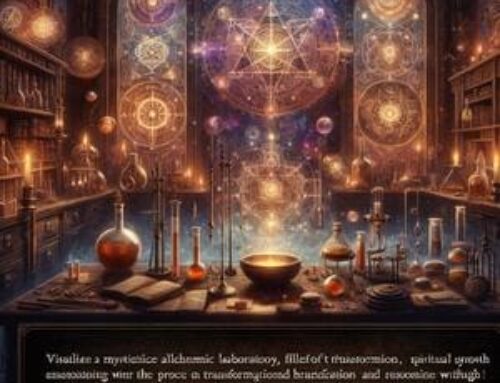Contents
- 1 The Philosophical Foundations
- 2 The Alchemical Stages
- 3 The Ultimate Goal
- 4 Conclusion of “Magnum Opus Definition”
- 5 FAQ- Magnum Opus Definition
- 5.1 1. What is the Magnum Opus in alchemy?
- 5.2 2. What are the main stages of the Magnum Opus?
- 5.3 3. What does the Philosopher’s Stone symbolize in the Great Work?
- 5.4 4. How does the Magnum Opus relate to spiritual practices?
- 5.5 5. Where can I learn more about the Great Work and alchemical practices?
- 6 References
Introduction to “Magnum Opus Definition”
“Magnum Opus Definition”, often referred to as the Great Work, is an alchemical term denoting the profound process of transformation aimed at achieving the Philosopher’s Stone. This pursuit encapsulates not only the transmutation of base metals into gold but also the quest for spiritual enlightenment and mastery over both material and spiritual realms. Rooted deeply in philosophy and mysticism, the “Magnum Opus Definition” embodies the alchemist’s journey toward eternal wisdom and divine essence. Here, we delve into the philosophical foundations, intricate stages, and ultimate goals of the Magnum Opus, drawing insights from Elias Rubenstein’s “Alchemy: Secrets of Consciousness Transformation.”

The Philosophical Foundations
Seeking the Absolute
The core of the “Magnum Opus Definition” lies in the relentless pursuit of the Absolute—ultimate truth and spiritual enlightenment. This quest, often called the Work of the Sun, highlights the alchemist’s journey toward the purest forms of knowledge and existence. Gold, in alchemical traditions, symbolizes not just material wealth but the epitome of spiritual perfection and divine splendor. Hence, the pursuit of the Great Work is essentially a journey to uncover the universe’s secrets, achieving a state of complete harmony with the divine.
Quintessence: The Universal Essence
A pivotal aspect of the Great Work is the extraction and refinement of quintessence—also known as the fifth element or Ether. This universal essence is critical for alchemical transformation, representing the purest form of spiritual and material essence (1). Quintessence, often referred to as the elixir of life, rejuvenates and purifies both body and soul, playing a vital role in the creation of the Philosopher’s Stone.
The Alchemical Stages
Calcination and Dissolution
The alchemical journey commences with calcination, where the base material is subjected to intense heat, reducing it to ash. This process symbolizes burning away impurities and the destruction of the old self to make way for the new. Following calcination, dissolution occurs, where the ash is dissolved in a solvent, representing the dissolution of the ego and the merging of the alchemist’s consciousness with the universal mind. These initial stages are crucial for purifying and transforming the base material into a higher form.
Coagulation and Fermentation
In coagulation, the purified elements are recombined into a new, stable substance, symbolizing the integration of the alchemist’s refined spirit with their physical form. Fermentation introduces new life and energy into the mixture, representing the awakening of divine wisdom and spiritual vitality. This stage signifies the rebirth of the alchemist as a transformed being, with heightened awareness and a deeper connection to the divine.
Distillation and Sublimation
Distillation involves heating the substance to separate the pure essence from impurities, reflecting the ongoing quest for purity and self-improvement. The final step, sublimation, transforms the purified substance into a higher form, representing the attainment of spiritual enlightenment and the manifestation of the Philosopher’s Stone. This stage marks the alchemist’s transcendence from the physical realm to achieve divine consciousness.
The Ultimate Goal
Inner Transformation and Enlightenment
Stabilizing physiological rhythms, such as breathing, heart rate variability or blood pressure variability, creates favorable conditions for achieving states of expanded consciousness, which can improve efficiency, creativity and spiritual growth (2).
The “Magnum Opus Definition” serves as a profound metaphor for inner transformation. It mirrors the alchemist’s journey of self-discovery, where layers of ego and material attachment are stripped away to reveal the true, divine essence within. This spiritual journey aims at achieving enlightenment, understanding the interconnectedness of all things, and aligning with universal laws of nature.
Spiritual journeying is a lifelong process that involves exploring one’s inner self and a larger cosmic consciousness (3).
The Philosopher’s Stone: A Symbol of Perfection
The Philosopher’s Stone, the ultimate goal of the Great Work, symbolizes the attainment of spiritual perfection and immortality. It represents the highest state of being an alchemist can achieve, marking the successful completion of the alchemical process. Creating the Philosopher’s Stone is not just a physical achievement but a metaphor for the inner light and wisdom guiding the alchemist toward higher consciousness and deeper divine connection.
Integration with the Divine
Alchemy emphasizes the integration with the divine essence. The “Magnum Opus Definition” teaches practitioners to recognize the divine presence within themselves and the world around them. By aligning with this divine essence, the alchemist achieves harmony and balance, transcending the limitations of the physical world. This ultimate integration leads to the realization of one’s true nature and fulfillment of spiritual potential.
Conclusion of “Magnum Opus Definition”
The “Magnum Opus Definition”, or the Great Work, in alchemy, represents a multifaceted journey of material and spiritual transformation. This profound process requires dedication, patience, and a deep understanding of natural and spiritual laws. Mastering the principles of the Great Work leads to a state of enlightenment and harmony with the universe. For those seeking to explore these esoteric mysteries further, the Hermetic Academy offers extensive resources and guidance on the path to spiritual transformation and enlightenment.
FAQ- Magnum Opus Definition
1. What is the Magnum Opus in alchemy?
A: The Magnum Opus, or the Great Work, is the ultimate goal of alchemy, representing the comprehensive process of transforming base metals into gold and achieving spiritual enlightenment.
2. What are the main stages of the Magnum Opus?
A: The main stages of the Magnum Opus include calcination, dissolution, coagulation, fermentation, distillation, and sublimation, each symbolizing a step in the spiritual and material transformation necessary to create the Philosopher’s Stone.
3. What does the Philosopher’s Stone symbolize in the Great Work?
A: The Philosopher’s Stone symbolizes the attainment of spiritual perfection and enlightenment. It represents the highest state of being that an alchemist can achieve, signifying the successful completion of the alchemical process.
4. How does the Magnum Opus relate to spiritual practices?
A: The Magnum Opus relates to spiritual practices by emphasizing the transformation of the self, aligning with divine essence, and achieving a harmonious balance between the material and spiritual realms. It teaches the practitioner to harness their hidden potential and connect with the universal laws of nature.
5. Where can I learn more about the Great Work and alchemical practices?
A: For those interested in delving deeper into the mysteries of the Great Work, the Hermetic Academy offers extensive resources and guidance on the path to spiritual transformation and enlightenment.
References
(1) Rubenstein, E. (2023). Alchemy: Secrets of Consciousness Transformation. Hermetic World, Paphos.
(2) Rădulescu, I., Drăgoi, A., Trifu, S., & Cristea, M. (2021). Neuroplasticity and depression: Rewiring the brain’s networks through pharmacological therapy (Review). Experimental and Therapeutic Medicine, 22. https://doi.org/10.3892/etm.2021.10565.
(3) Keegan, L. (1991). Spiritual Journeying. Journal of Holistic Nursing, 9, 14 – 3. https://doi.org/10.1177/089801019100900103.





